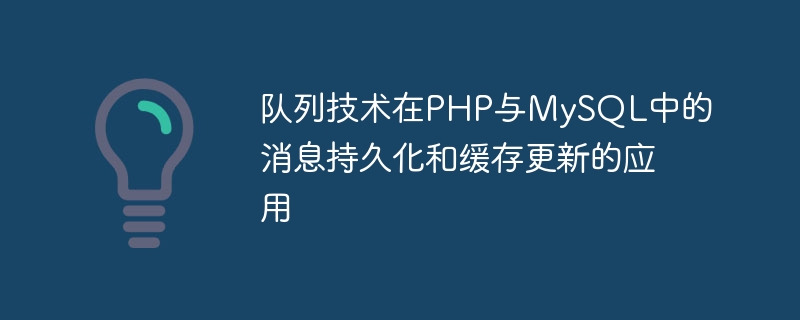Home >Backend Development >PHP Tutorial >Application of queue technology in message persistence and cache update in PHP and MySQL
Application of queue technology in message persistence and cache update in PHP and MySQL
- 王林Original
- 2023-10-15 11:42:231130browse

Application of Queue Technology in Message Persistence and Cache Update in PHP and MySQL
With the booming development of the Internet, Web applications are becoming more and more complex. . In such an environment, message queue has become an important technical means for asynchronous processing tasks and improving application performance and scalability. In PHP and MySQL applications, it is very useful to use message queues to implement message persistence and cache update functions. This article will introduce how to use queue technology to implement message persistence and cache updates, and provide specific code examples.
1. Message persistence
Message persistence refers to saving messages in the queue to prevent message loss or system failure that causes the message to be unable to be sent. In PHP and MySQL applications, we can use message queues to achieve asynchronous storage of data, thereby improving the throughput and response speed of the application.
We can use Redis as a message queue implementation tool by serializing the data to be saved into JSON format and storing it in the Redis queue. The following is a sample code:
<?php
$redis = new Redis();
$redis->connect('127.0.0.1', 6379);
$data = array(
'id' => 1,
'name' => 'John',
'email' => 'john@example.com'
);
$encodedData = json_encode($data);
$redis->lpush('message_queue', $encodedData);
?>In the above code, we first connect to the Redis server, then convert the data to be persisted into JSON format, and insert it into the queue through the LPUSH command. In this way, we achieve message persistence.
2. Cache update
Cache is one of the key factors to improve the performance of web applications. When a piece of data changes, we need to update the cache to keep the data up-to-date. By using message queues, we can update the cache asynchronously and improve the response speed of the application.
In PHP and MySQL applications, we can use message queues to implement cache updates. The following is a sample code:
<?php
$redis = new Redis();
$redis->connect('127.0.0.1', 6379);
$mysqli = new mysqli('localhost', 'username', 'password', 'database');
$id = $_POST['id'];
// 更新MySQL数据库中的数据
$query = "UPDATE users SET name='John Doe' WHERE id = $id";
$result = $mysqli->query($query);
// 发送消息到队列,通知更新缓存
$message = array(
'id' => $id,
'action' => 'update_cache'
);
$encodedMessage = json_encode($message);
$redis->lpush('message_queue', $encodedMessage);
?>In the above code, we first establish connections with Redis and MySQL servers. When receiving a request to update data, we first update the data in the MySQL database, and then send a message to the queue to inform the application that the cache needs to be updated. After serializing the message into JSON format, use the LPUSH command to insert it into the queue.
3. Message processing
In PHP and MySQL applications, we need a message processor to process the messages in the queue and perform corresponding operations. The following is a sample code:
<?php
$redis = new Redis();
$redis->connect('127.0.0.1', 6379);
while (true) {
$encodedMessage = $redis->brpop('message_queue', 0)[1];
$message = json_decode($encodedMessage);
switch ($message->action) {
case 'update_cache':
// 更新缓存
updateCache($message->id);
break;
// 其他操作
}
}
function updateCache($id) {
// 更新缓存的具体实现
// ...
}
?>In the above code, we use Redis's BRPOP command to obtain messages from the queue in a blocking manner and decode the messages. Based on the action of the message, we perform the corresponding operation. In this example, we update the cache.
Summary:
The application of queue technology in message persistence and cache updates in PHP and MySQL is an important means to improve application performance and scalability. By saving messages in the queue, we can achieve asynchronous saving of data and asynchronous updating of cache. This article introduces how to use Redis as a message queue implementation tool and provides specific code examples. I hope this article can help readers understand the application of queue technology in PHP and MySQL and be able to use it in actual projects.
The above is the detailed content of Application of queue technology in message persistence and cache update in PHP and MySQL. For more information, please follow other related articles on the PHP Chinese website!
Related articles
See more- Examples of message queue technology in PHP and its application in the framework
- Cache update mechanism in Java caching technology
- Nginx proxy cache update configuration to respond to website changes in real time
- Design and implementation of message persistence and data security using Golang and RabbitMQ
- Application of queue technology in delayed message processing and data caching in PHP and MySQL

